This coming Monday, I make the transition from years and years of being a student to now being in the teacher position. I'm in my last semester of my graduate degree. Come December I'll have a masters degree in Art Education and I'll be fully certified to teach Art in Florida. Since it is my last semester, that means full time student teaching/interning - I'll be spending 7 weeks in a High School Art classroom and 7 weeks in an Elementary school classroom. I'm very excited, anxious, eager, nervous, and a whole lot of other adjectives. I know I'm going to learn SO much about how to teach and I'm really looking forward to this experience!
That being said, the weeks leading up to internship have been filled with lots of things I know I won't have the time to do during the school year. I've been doing lots of wedding things (Just 57 days until the Big Day!), like putting together favors, finalizing details, dress fittings, hair trial runs, and more. I've also been spending a LOT of time in the kitchen cooking and baking because I know sadly I won't have as much time to do those things as I do now.
I know I don't talk about Cooking very often on this blog, but I do actually like to cook very much. Maybe that's because dinner doesn't stick around long enough to get photographed (it usually get devoured as soon as it is done). Or maybe it's because chicken parmigiana just doesn't look as cute in pictures as a stack of brownies does. But my-really OUR because the wonderful fiance helped tremendously with this one-latest cooking escapade definitely warrants a blog post.
For my bridal shower, I got a Pasta Excellence Set for the KitchenAid mixer along with a "Greatest-Ever Pasta Cookbook"! I was SO excited to get this - it comes with a pasta roller, a spaghetti cutter, a thick noodle cutter, an angel hair cutter, a fettucini cutter, and a ravioli maker. The cookbook I got along with it is perfect for beginners - it explains every step of the pasta-making process in detail and shows pictures at each stage. Very helpful when you're attempting this task for the first time! We made the book's Basic Egg Pasta Dough (with some slight alterations which I'll include below) for our first Pasta-Making Session.
Basic White Whole Wheat Egg Pasta adapted from the Greatest-Ever Pasta Cookbook
4 Cups White Whole Wheat flour
1 1/2 Cups All Purpose Flour (both flours together should weigh 600 grams)
6 eggs, room temperature
2 tsp sea salt
1/4 Cup water, for use as needed
1. Sift the flours together and make into a mound on a clean work surface. Use your fingers to make a deep well with high sides in the center of the mound.
2. Crack the eggs into the well and add the salt. With a fork, mix the wet ingredients together and slowly start incorporating flour from the sides of the mound into the wet ingredients. Be careful to not break the sides of the well or spill the wet ingredients over the sides of the mound or you'll have a big mess. Be patient, this is going to take a while.
3. When enough flour is mixed in that the mixture in the center is no longer liquid, use your hands to work the ingredients together into a sticky dough. Get all of the sticky mixture off of the work surface and work into the dough ball. If the dough seems too dry, start adding water by the Teaspoonful into the dough. If it is too moist (a problem which I didn't have), add some flour.
4. Form a rough ball and knead it. Take the heel of your hand, and push the dough away from you. Fold it back on itself and repeat. Be sure to turn the dough and continue kneading every few minutes. After several minutes of kneading like this, you could throw it in your KitchenAid mixer with the dough hook attachment and knead it for a few minutes to help form the dough. You will likely still need to knead it by hand a bit after this, but it helps speed up the process. Thorough kneading is very important! Your dough isn't kneaded thoroughly unless it is very smooth and has some elasticity. This is the hardest step!
5. Wrap the dough in plastic wrap and allow to rest for 15-20 minutes at room temperature. It will be ready to roll after this waiting period. *If you plan on making ravioli, now would be a good time to prepare your filling!
Now, break out the Pasta Roller!
Use it on the thickest setting at first (#1). Break off a chunk of dough slightly larger than a golf ball. Use your fingers to press it down into a rough sheet. Put it through the pasta roller on the widest setting a few times. Next, take it to the next setting on the pasta roller - a little bit thinner (#2). Run it through this next setting a few times. Then, fold the dough in half and insert the folded end into the roller. Run it through a few times like this before moving it up to the next setting (#3) and repeat all the way until the dough is rolled out at the #4 setting. If the dough is forced to go through the roller on too-thin of a setting when it isn't ready, it will break apart and will likely get too dry to be able to be used at all (we learned this the hard way). As you make pasta sheets, lay them out on your clean work surface and cover with plastic wrap as you make the rest of your sheets.
When the dough is at the thickness of the #4 setting, it is ready to be made into pasta. We made it into a variety of pastas -
Some spaghetti:
As you cut the spaghetti, put on a lined cookie sheet and toss with flour to prevent the dough sticking together.
Roughly form little "nests" with the spaghetti.
Now you can do one of three things:
1. Allow the pasta to dry for one hour and then throw it in boiling water for around 4 minutes and eat it!
2. Allow it to dry for a couple of hours until it feels a little bit stiff but not as stiff as boxed pasta. Then, plastic wrap or zippy bag the nests and freeze until ready to use. You can put the home-made frozen pasta into boiling water for about 4 - 5 minutes and it'll be ready to eat. Consume within 3 months.
3. Let the nests dry for 24 hours until it feels stiff like boxed pasta. It can be stored in airtight storage containers in the pantry. Consume within 3 months.
Voila! Home-made pasta ready for whenever you want it!
We made lots of ravioli, too:
To make the ravioli is surprisingly easy! Take a long sheet of pasta dough, fold it in half and insert the folded end into the ravioli attachment. Using the hand crank, turn the knob one quarter turn to feed the pasta sheet. Take the filling scoop and insert 1 - 2 scoops of the filling of your choice (2 ideas below!). As you turn the hand crank, the filling automatically fills in the little pockets of the ravioli and seals the edges. A little filling goes a long way, so don't put too much in. If you get to the end of the dough and there is filling left, it might get a little messy. :)
Once the sheet is completely through the ravioli maker, tear the sheets of ravioli apart at the perforations. Lay the ravioli out on a cookie sheet lined with a clean dish towel. Allow to dry for one hour before cooking. The raviolis will only take about 4 - 5 minutes in boiling water to be done and ready to eat! (Or you can freeze the little raviolis after their initial drying period and boil them up whenever you want them).
With ravioli fillings, you can get pretty creative. Just one thing to keep in mind is that fresh ravioli only need to boil for 4 - 5 minutes, so anything you put in should be fully cooked. In our first ravioli making sessions, we made two fillings:
Spinach and Ricotta Cheese Ravioli Filling:
3 Tblspn unsalted butter
6 oz fresh spinach, washed and shredded
1 Cup ricotta cheese
1/3 Cup grated Parmigiano-Reggiano cheese
a pinch of nutmeg
1 egg, room temp
sea salt and pepper to taste
Melt the butter in a small saucepan. Add the spinach, salt and pepper and cook for 6 - 8 minutes on medium heat. Stir frequently until the spinach is wilted. Increase the heat to high and stir for a few minutes to dry out the spinach a little bit. Transfer to a mixing bowl and allow to cool.
When cool, add ricotta, grated cheese, and nutmeg. Mix well, taste for seasoning. Then when you're happy with the seasonings, add the egg and mix well. It is ready to be put into ravioli!
Spicy Sausage and Spinach Ravioli Filling:
1 Tblspn olive oil
2 spicy italian sausage with the casings removed
1 Cup ricotta cheese
3 oz fresh spinach, washed and shredded
1 egg, room temp
Grated cheese, salt, and pepper to taste
Over medium heat, cook the sausage in a small pan until meat is browned and cooked thoroughly, and a lot of the liquid has cooked away. Remove to a mixing bowl and allow to cool.
Add the olive oil and spinach to the still hot pan and cook, covered, until wilted. When it has wilted, gently squeeze some of the liquid out of the spinach and discard the liquid.
Mix the sausage, spinach together with the ricotta, grated cheese. Add grated cheese, sea salt and pepper and taste for seasoning. If you're happy with the seasoning, add the egg and mix well. It's ready to be put into your raviolis!
So that I could get a feel for the taste of the ravioli, I didn't want to cover it in a red sauce. Instead, I made a simple Browned Butter and Sage sauce. It is so simple I hesitate to even call it a sauce, but it is soo good. Browned butter is nice and nutty and has much more depth as a result of browning. When you add sage and sea salt... you'll just have to try it to understand.
Browned Butter and Sage sauce
3 Tblspn butter
8 - 12 leaves of Fresh Sage, washed and dried
Sea Salt for serving
Grated parmigiano-reggiano cheese for serving
Melt the butter on medium heat and add the sage leaves. Cook it over medium heat until it browns. Here is a little tutorial on how to brown butter if you're not familiar.
When cooking your pasta, save a little bit of the pasta water when straining. Add the browned butter and sage to the pasta water and pour over your pasta. Sprinkle sea salt on top of your pasta, add some grated cheese and enjoy! (Adding sea salt brings out the flavor of the browned butter as well as the sage. Without it, it'll just taste like.. butter. So skipping the sea salt is NOT ok!! You'll be missing out!).
Here is only our spread of the pasta we made that night:
WHEW, that was a long post. I suppose it makes sense because the pasta-making was a long process. But it was a lot of fun. Actually since then, we've actually made MORE pasta. I can't wait to play around and make all kinds of different flavors or pasta dough. I'd definitely recommend this recipe for the ravioli dough as it was nice and simple and really let the flavor of the filling shine through. However next time I'd probably make something a little more flavorful for the spaghetti and non-stuffed pastas. But don't get me wrong, it was still delicious. :)
Next post up before Student Teaching starts? Canning home-made Tomato Sauce! You'd never guess me and the fiance are in our mid twenties, you'd think we were little old Italian women. At least we eat well!




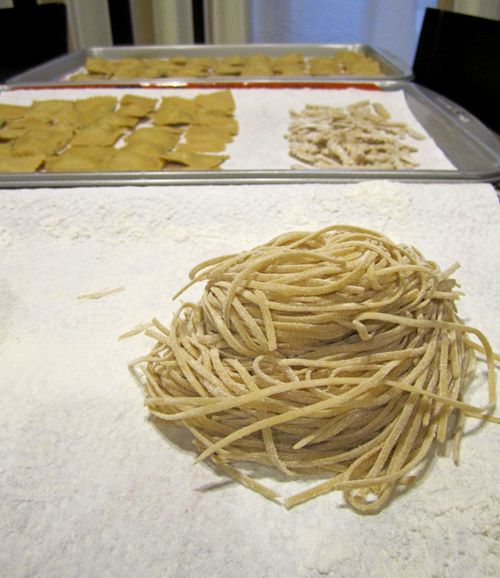
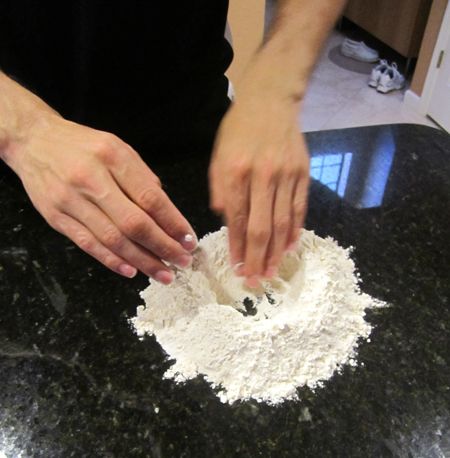
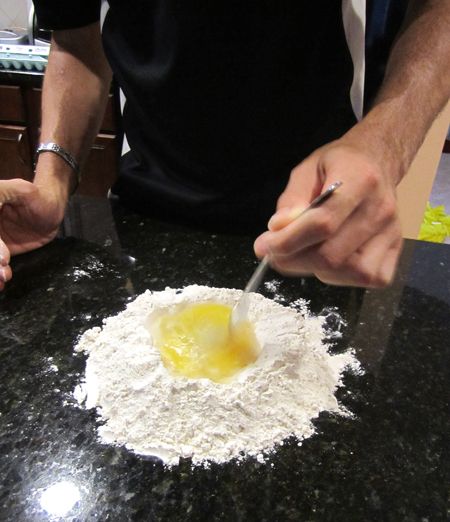

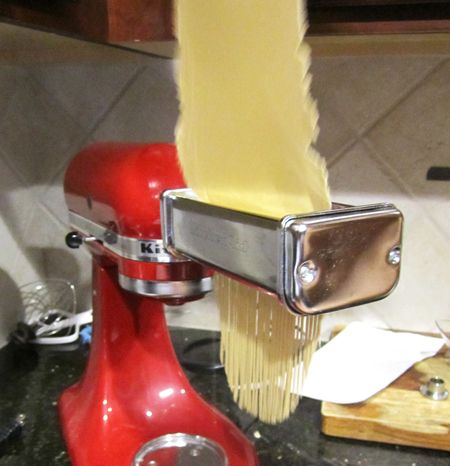
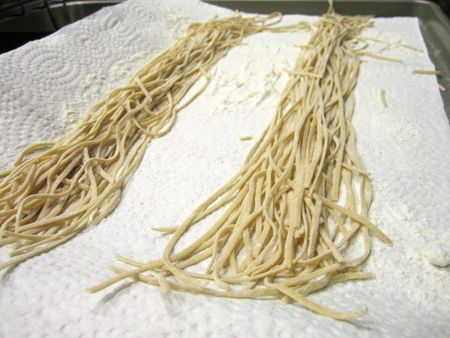

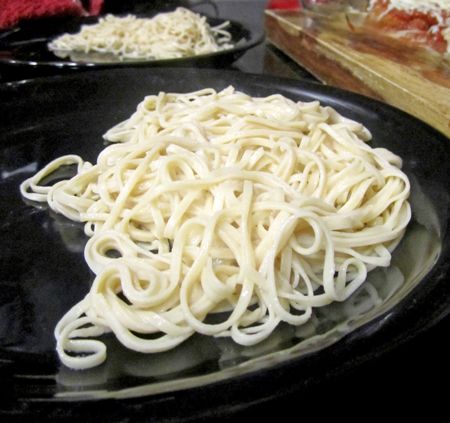

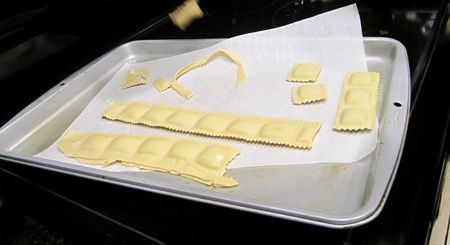
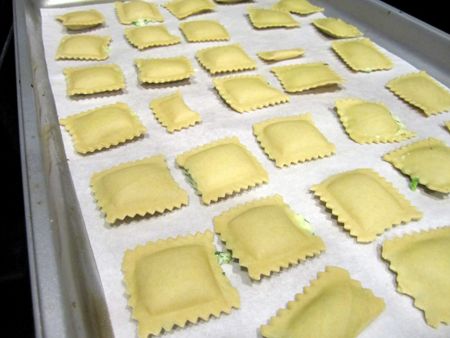
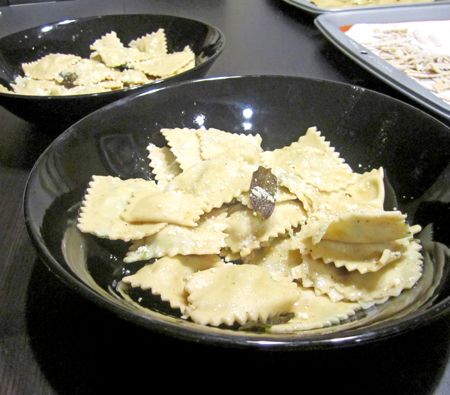
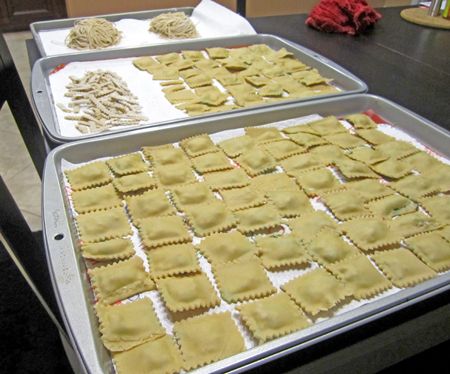




3 comments:
Great Job Hun! I have a Pasta Maker however I have yet to venture into those grounds. You have inspired me to do so...after this weekend - maybe the longweekend I shall tackle the ever so yummy fresh pasta cook!
THANKS
XOXO
Yours Truly
Wow. You make this all sound so easy! I made pasta only one time and it didn't go at all this smoothly for me and I swore I wasn't ever going to try it again. And now this! I'm actually considering getting the kitchen aid attachment just from seeing your post! : )
PS- Don't you love the KA white whole wheat flour? We use it for everything!
Wow that is a ton of great stuff! Bridal shower gift, teaching Art and all that yummy pasta! Your life is wonderful!!
Post a Comment